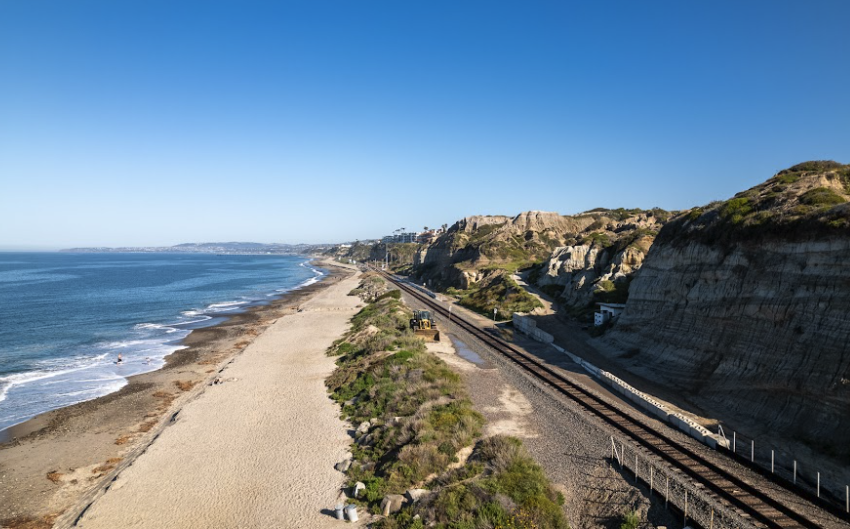
Last week, the California Coastal Commission issued a limited Emergency Coastal Development Permit (ECDP) to the Orange County Transportation Authority (OCTA) to address bluff and beach erosion along the rail corridor in San Clemente. While OCTA asked for emergency authorization across four erosion “hotspot” areas, the Commission only approved work in three of them — and notably, did not approve new shoreline armoring at San Clemente State Beach (Area 4). Thank you to everyone who signed our action alert to save San Clemente State Beach — it worked!
Here’s what was approved:
- Areas 1 & 2: Reinforcement of existing rock riprap and a large-scale sand nourishment project (240,000 cubic yards) aimed at temporarily buffering the rail corridor from storm damage.
- Area 3: Demolition of the Mariposa Pedestrian Bridge and site grading, where recent landslides threaten the inland side of the tracks. This is a first step toward eventual replacement and restoration of the California Coastal Trail.
And what wasn’t:
- Area 4 (San Clemente State Beach): The Commission did not approve any new revetment or seawall. Staff concluded OCTA hadn’t provided enough data to justify an emergency and emphasized that even in urgent situations, emergency work must still meet the Coastal Act’s standard of avoiding or minimizing coastal resource impacts.
What this means: This decision sets an important precedent: emergency permits aren’t a blank check to destroy public beaches. The Coastal Commission rightly demanded more transparency, more data, and more meaningful alternatives before greenlighting permanent impacts to a cherished state park, campground and surf zone.
What happens next: OCTA will still need to submit regular Coastal Development Permits to permanently authorize any of the emergency work as a follow up to the emergency permit. As part of that process, they’ll be required to analyze long-term options, including real transportation and adaptation alternatives. In the meantime, we’re calling on OCTA to explore non-armoring solutions, like expanded sand placement and service shuttles, which they’ve successfully used in the past, to avoid armoring San Clemente State Beach.
Notably, the ECDP states in Special Condition 7, OCTA “may be required to complete a Railroad Relocation Analysis for the relocation of the railroad line from its present location in a coastal hazard zone as a part of the required follow up CDP(s).” Surfrider supports this requirement and urges the Coastal Commission and OCTA to complete this analysis.
It's possible that OCTA will still apply for a regular coastal development permit to armor San Clemente State Beach in the future, or reapply for an emergency permit with more information. We’ll be watching closely as the regular CDPs come forward, and we’ll keep pushing for a smarter, more sustainable approach to protecting both the rail line and our coast.
In the words of the late Peter Douglas, longtime director of the California Coastal Commission, “The coast is never saved; it's always being saved.” As we are excited about the outcome of last week, we will be looking forward to see how things develop next. Stay tuned for more updates!
